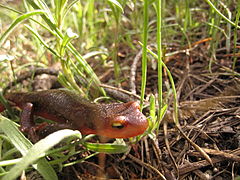Taricha sierrae
| Sierra newt Taricha sierrae |
|
|---|---|
 |
|
| Scientific classification | |
| Kingdom: | Animalia |
| Phylum: | Chordata |
| Class: | Amphibia |
| Order: | Caudata |
| Family: | Salamandridae |
| Genus: | Taricha |
| Species: | T. sierrae |
| Binomial name | |
|
Taricha sierrae |
|
The Sierra newt, with scientific name Taricha sierrae, is a newt found west of the Sierra Nevada, from Shasta county to Tulare County, in California, Western North America.
Its adult length can range from 5 to 8 in (13 to 20 cm). Its skin produces a potent toxin.
The Sierra newt was formerly regarded as a subspecies (Taricha torosa sierrae) of the California newt (Taricha torosa). In 2007 it was determined that the two represent "distinct evolutionary lineages".
Sierra newts exist primarily in the Sierra Nevada, because they prefer less humid climates than the rough-skinned newts. Outside the breeding season, the newts are land-dwelling, preferring rock crevices and logs.
Reproduction occurs generally between December and early May. Typically, the adult newts will return to the pool in which they hatched. After a mating dance, the male mounts the female and rubs his chin on her nose. He then attaches a spermatophore to the substrate, which she will retrieve into her cloaca.
The egg mass released by the female contains between seven and 30 eggs, and is roughly the consistency of a thick gelatin dessert. Typically, the egg masses are attached to stream plant roots or to rocky crevices in small, pools of slow-moving water, but they have also been known to be attached to underwater rocks or leaf debris. While shallow in a wide sense, these pools are rather deep relative to the average depth of a Southern California stream, varying in depth from about 1–2 metres (3.3–6.6 ft).
Adult newts will stay in the pools throughout the breeding season, and can be occasionally found well into the summer. Larvae hatch sometime in early to midsummer, depending on local water temperature. Larvae are difficult to find in streams, as they blend in well with the sandy bottom, to which they usually stay close.
...
Wikipedia


